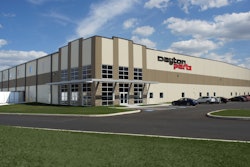The following comes from the April 2019 issue of Truck Parts & Service. To read a digital version of the magazine, please click the image below.
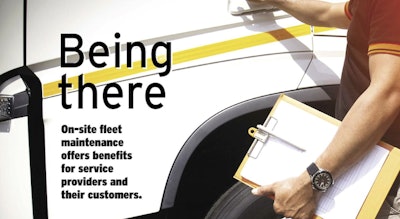
Providing additional services to customers can be good for business. Performing on-site maintenance for fleets creates additional customer stickiness and revenue for the aftermarket provider and the fleets have less to worry about if they have a partner scheduling and servicing their vehicles.
“The primary benefit for the client is it minimizes or eliminates vehicle downtime for routine maintenance and … repair work because [it’s completed] outside of business hours. We’re working when their trucks aren’t. It also eliminates vehicle shuttle time to a shop,” says Paul Rygalski, president, Managed Mobile. “On the maintenance management side, clients don’t have to dedicate office personnel to managing, tracking, scheduling and executing all their fleet maintenance.”
Addressing the advantages to the provider, PennFleet Owner Jim Kolea says, “The obvious benefits are being able to cross market services to a customer base that has different needs. Some of our customers utilize our emergency road and collision services but not our on-site services and others use us exclusively for on-site service. We want to be able to partner with and help the customer as much as possible. If we can make our customers and employees successful, the company always wins.”
Another benefit to providing the service is “it allows us to grow our business without the cost of additional facilities,” says John Wensel, owner, Wensel’s Service Centers. “It also fills an industry need because a lot of directors of maintenance are looking to minimize their downtime.”
Several experts explain how and why they began offering on-site fleet maintenance, the challenges inherent to it and tips for service providers considering offering it to their customers.
Getting into the biz
From the company’s onset, California-based Managed Mobile’s primary focus was to be a mobile service for fleets. The company started out performing on-site preventive maintenance (PM), such as oil changes, lubrication services and vehicle safety inspections. “The clients loved having the PMs on site and then they wanted the repairs done on site, so we evolved into a full-service maintenance company,” Rygalski says.
Approximately 80 percent of Managed Mobile’s business is scheduled and the other 20 percent is comprised of unexpected repairs performed on-site or 24/7 emergency road service for clients part of Managed Mobile’s Fleet Service Plan. Rygalski says the company limits the around-the-clock emergency roadside service to plan members because, “if you start dropping in a bunch of unexpected events, it disrupts everything.”
Managed Mobile maintains a well-organized business. While one aspect of the company is the technicians out in the field, the other aspect is a large staff of fleet coordinators who plan service for customers.
“They’re coordinating and direct-ing the maintenance for each client. We manage their PM schedule, state and federal safety inspection compliance and repairs,” Rygalski says. “Our goal is to be making the calls, not taking the calls.”
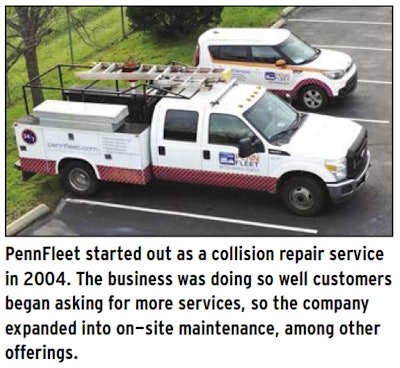
“We listened to our customers and we found if you listen to what the customer needs and help them achieve that, it is easy to succeed,” says Kolea.
In addition to performing PM for trailers and dollies, PennFleet also provides services for power vehicles, including driver vehicle inspection reports, which need to be completed daily, and a large variety of inspections and repairs, such as clutch adjustments, hydraulic and coolant hoses, air brakes, suspensions, dead batteries and computer diagnostics, to name a very few. “Basically, we do anything that can be performed safely on site,” Kolea says.
Though Wensel’s provides more emergency road service than on-site fleet maintenance, the company has two large accounts, one of which has more than 150 units, as well as several smaller clients with five or fewer trucks.
The company’s customers had approached it about offering on-site fleet maintenance and Wensel’s began providing it in 2005. Most of the on-site services the company offers include truck and trailer PM, DOT inspections at intervals clients establish, tire replacement, trailer door and roof repairs and engine diagnostics, Wensel says.
“We choose what services to perform based on the difficulty to do outside, whether it’s weather- or test-equipment related,” he says. “Basically we won’t do engines, transmissions, clutches and some wiring issues, but we will try to diagnose some of that on site.”
On-site fleet maintenance also makes up a large majority of the services Dickinson Fleet Services provides, but it didn’t start out that way. The company began in 1997 with three service garages in Atlanta, Indianapolis and Philadelphia. By the early 2000s, the company was proactive in scheduling clients’ vehicles to come into their shops for PM and inspection services, says Ted Coltrain, executive officer, Dickinson Fleet Services.
“What began to happen was customers were saying they were up against traffic and hours of service and they needed to get their trucks serviced somewhere closer, ‘but I appreciate the reminder,’” Coltrain says. “We realized quickly we needed to figure out a way to get closer to our customers and make it more convenient for them, particularly as it pertained to these scheduled service events.”
The answer was outfitting mobile trucks to do those types of services. “We tested it in Atlanta and it grew very quickly based on the convenience factor,” he says. “We expanded across the country from there.”
On-site challenges
Along with the benefits to on-site fleet maintenance come the challenges associated with it. Weather, working surface, technician skill, how big the job is and how small the client’s lot is all factor into the services that can be provided.
“If clients have a tight yard or limited space and it is going to be a big job that will require us to be in their yard all day long, we might have them bring that vehicle to one of our locations,” says Rygalski. “Another example is if they have a gravel yard and we need to do a clutch or transmission. Obviously you can’t roll a transmission jack on that type of surface, so we’ll bring it in to one of our facilities.”
Other limitations to on-site work are inclement weather and major internal engine work, he says, adding, “We do everything on site up to and including clutches and transmissions.”
For niche services Managed Mobile doesn’t provide, such as windshield glass, tires or bodywork, the company uses its network of vendors. Rygalski says coordinators will manage everything the client requires in order to provide customers complete service.
Another challenge for on-site service providers is communication with the customer. Much of the maintenance and repair work is done after hours when the trucks are back in the yard and the business is closed.
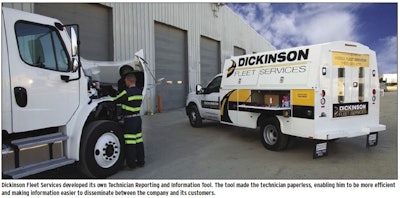
“Think about a technician who is in the field getting a truck fixed — he’s buying parts, creating a repair order, doing inspection sheets — there’s a ton of things we have to collect internally to make sure we can complete that transaction to maintain success in our business,” Coltrain says.
“We determined it was taking us a tremendous amount of time to generate an invoice for our customer and that created problems because customers were getting invoices for repairs completed 45 days ago. It was taking us that long to collect all the information. And, the customers weren’t around to inform them the truck was ready to go,” he says.
To that end, Dickinson Fleet Services developed its own Technician Reporting and Information Tool, or TRAIT. The tool made the technician completely paperless, enabling him to be more efficient and making information, now in digital form, much easier to disseminate between the company and its customers. In addition, Dickinson Fleet Services equipped its trucks with telematics and geofencing to alert clients, regardless of the time, when its service trucks were approaching their yard.
An additional hurdle to providing the service is finding technicians willing to work outside of normal business hours. “You have to find the right technicians for that kind of work. I find that to be a limitation sometimes,” Wensel says.
The company solved the issue by using three technicians who rotate every couple of days, working 5 p.m. to midnight, or whenever the work is done. “We give them a shift-differential pay rate, and they like making the extra money,” Wensel adds.
Adding on-site maintenance service
Service providers may consider providing on-site services to add another revenue stream and strengthen a customer’s reliance on their services.
However, these additional services must be done well or the entire business can suffer. The service community must avoid taking on more than they can handle as well as consider other facets of the business, say on-site fleet maintenance providers.
“Start small so you don’t overpromise and under deliver,” Kolea says. “Don’t go out and get 10 customers totaling thousands of vehicles and expect to be able to handle peak periods with only one truck.”
Wensel agrees. “You need to know your limitations, be honest with your customers and try not to be everything to everybody. It’s easy to buy equipment and get clients but you have to be able to do the work,” he says.
For aftermarket service providers that don’t have a parts business, having a good vendor network and an established parts distribution organization supporting the company is important, says Coltrain. “Our trucks will hold $3,000 worth of inventory but that doesn’t come close to covering all of the demand on the parts side.”
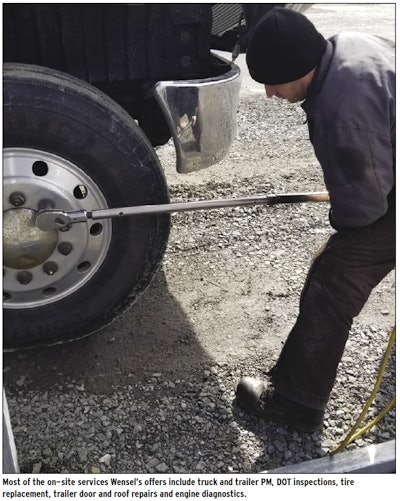
“I consider our company in the logistics business and we’re delivering fleet maintenance to the client. Our challenge is in coordinating with clients and determine what parts and special equipment the technician will need,” he says. “Most of these things are moving targets … and we must execute getting all of that at one place at one time for the repair to be successful.”
Then there’s the matter of not just having technicians willing to work the odd hours but having quality technicians — who are essentially the lynchpin to successfully providing on-site service. On-site maintenance providers stress the difference between on-site technicians versus those in the shop. On-site technicians have to be adept problem solvers because they don’t have the resources in the shop or colleagues to consult when doing a job.
“You have to have a technician train-ing program to be able to develop your technicians and you must have, especially doing mobile work, well-defined and well-enforced safety protocols and procedures,” Rygalski says.
Wensel says, “Any company can say, ‘I’ll do all of the fleet maintenance at night and on the weekends,’ and you can buy trucks and equipment, but do you have competent people who can do the job well? If not, you’re going to lose the business, so what did you gain?”


